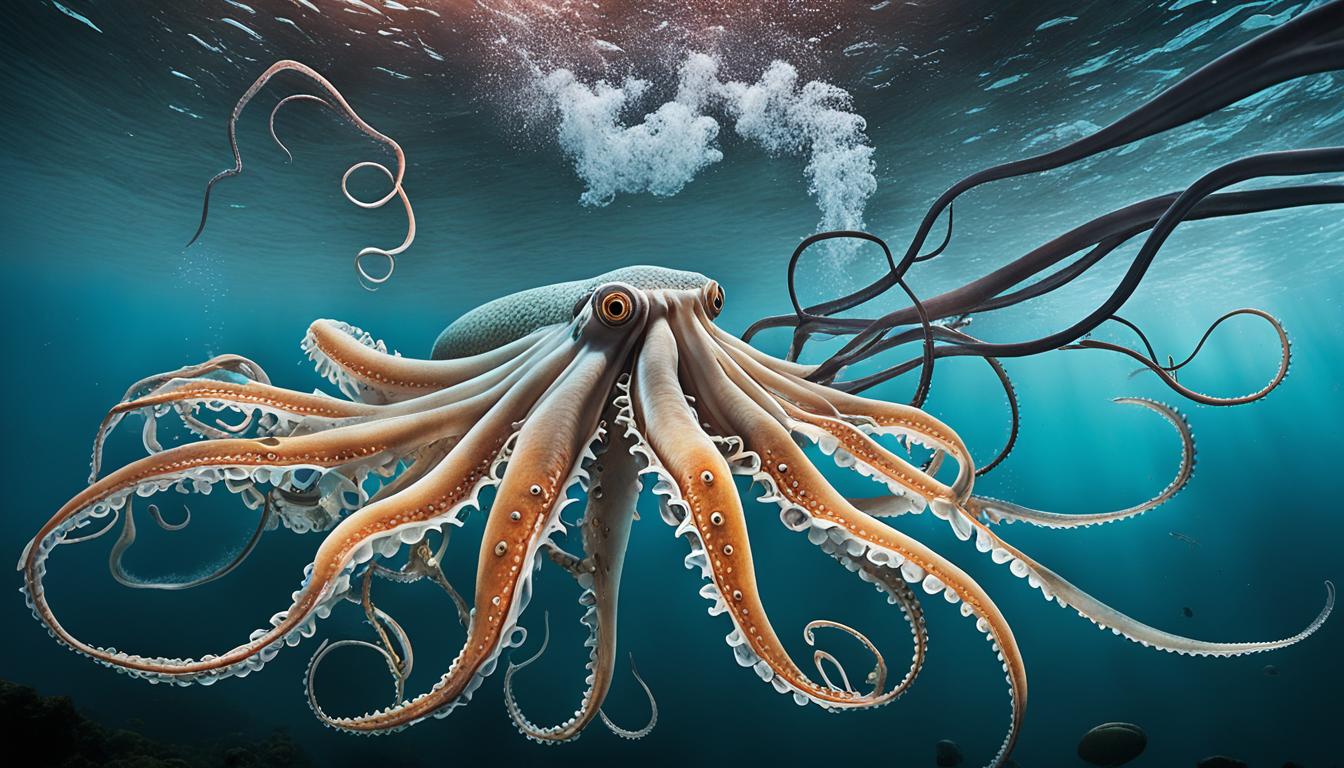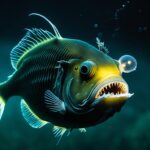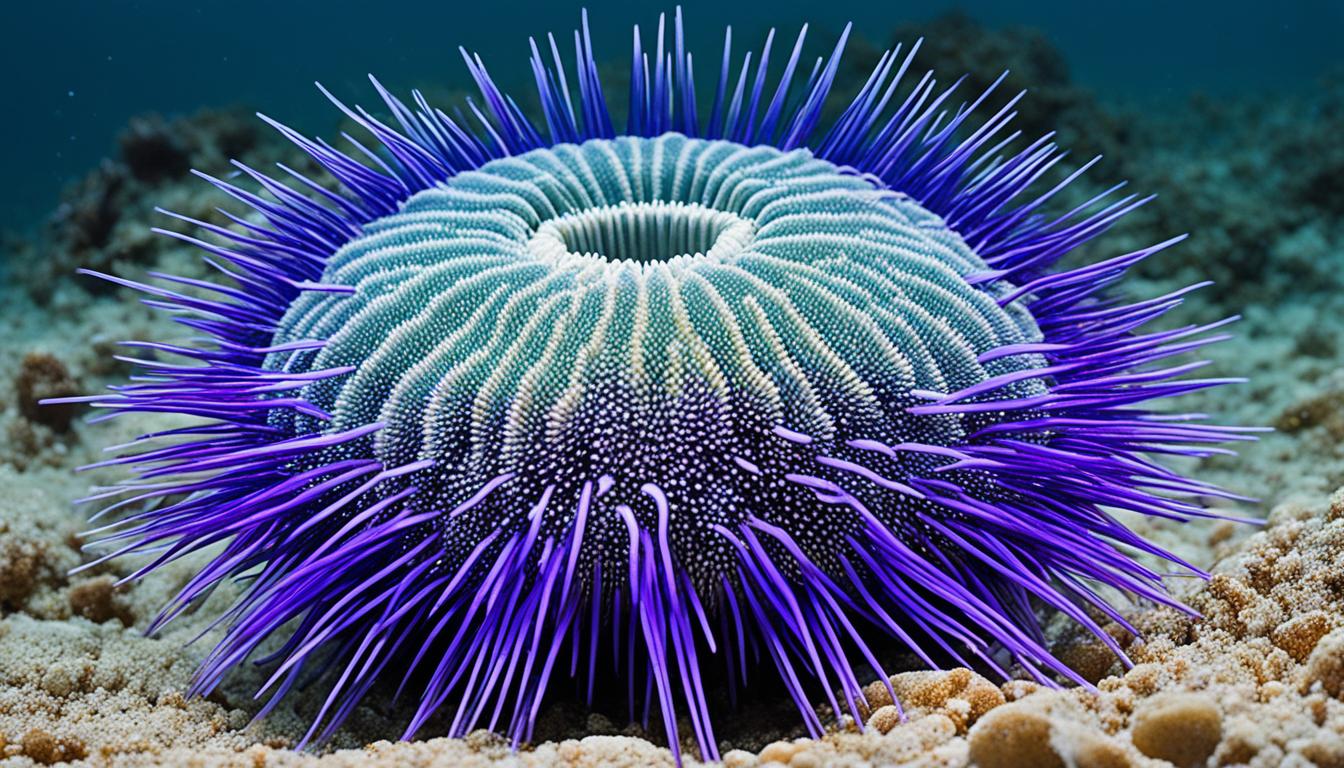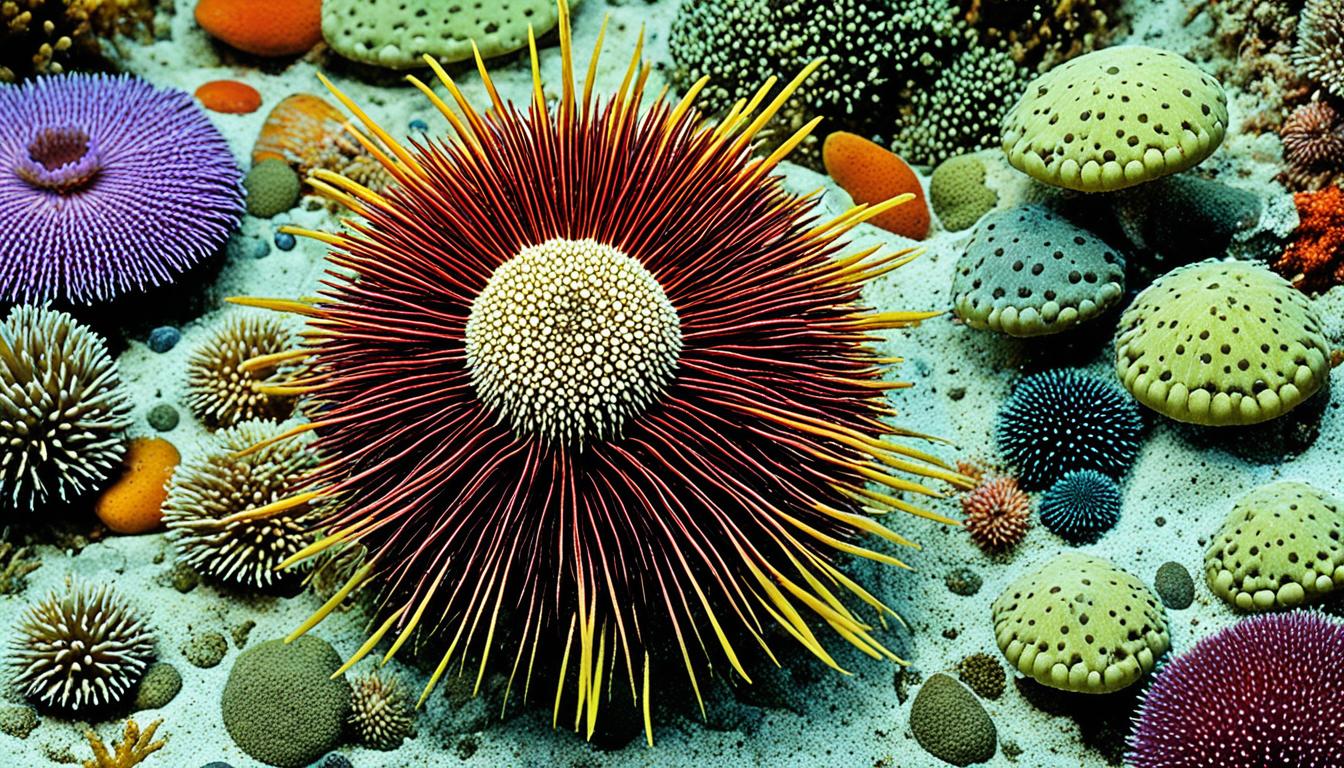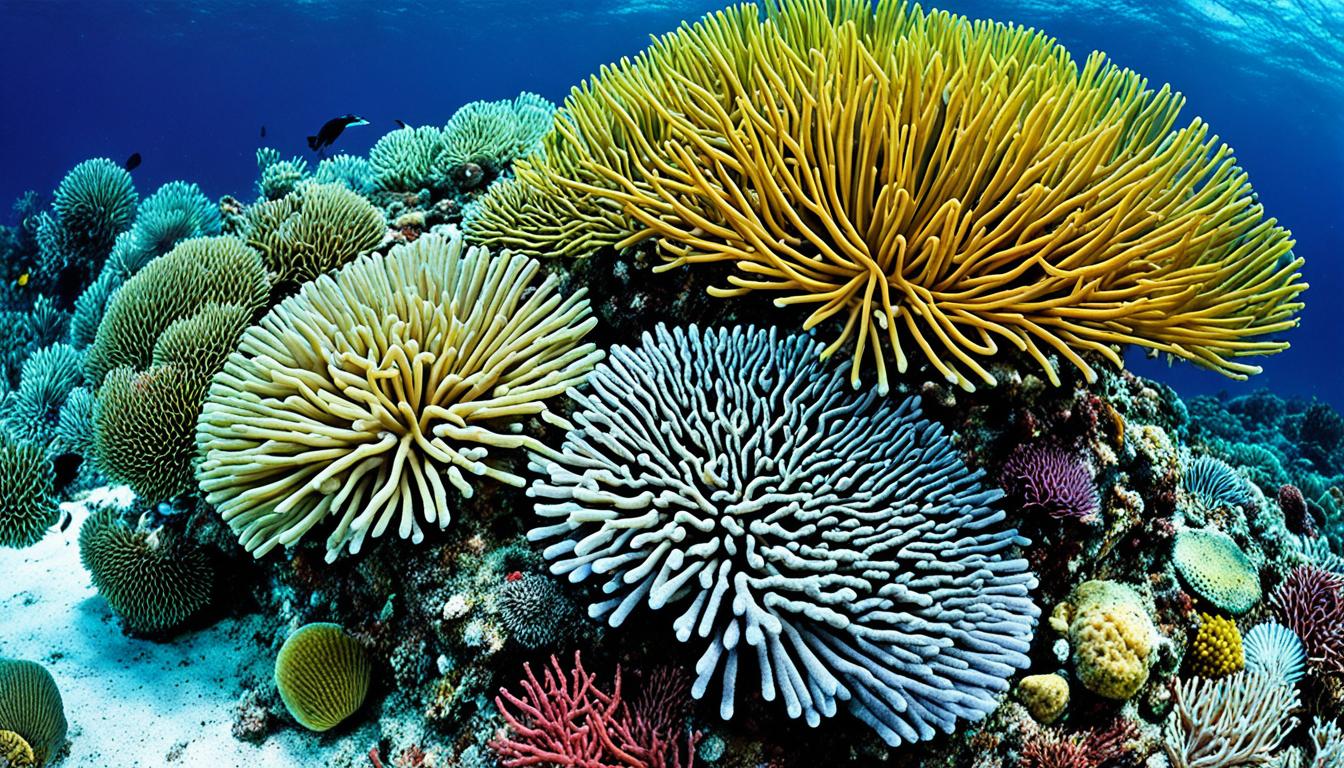Giant squids are fascinating creatures of the deep sea. They catch the attention of researchers and sea lovers. By looking into how they interact with other sea life, we see their important roles in the ocean.
These huge beings have tentacles up to 43 feet long. They are part of a complex network of relationships. These relationships help them survive and keep their home healthy.
They interact with different prey and compete for food. This shows how giant squids are key to keeping the ocean’s food webs balanced. Next, we’ll dive into their behavior, what they eat, and how they relate to other sea creatures.
Understanding Giant Squids and Their Ecosystem
Giant squids, known as Architeuthis dux, are among the biggest invertebrates in the ocean. They can reach lengths of up to 13 meters. These creatures prefer temperate waters, avoiding the harsh conditions of polar and tropical areas.
They live in depths of 300 to 1,000 meters. This deep living leads to a unique trait called abyssal gigantism. They grow big because there’s less food. Their bodies are made for hunting, with eight arms and two long tentacles to catch prey.
Learning about giant squids helps us understand their role in the ocean. Their unique body features let them survive in deep water. By studying them, scientists learn how they affect marine life, impacting both prey and other predators.
Giant Squids Behavior and Social Interactions
Giant squids show us how fascinating their behavior and social life can be. They often prefer to be alone, swimming through the open sea or hunting by themselves. They have amazing skills, like using ink to hide from danger and changing their skin color and texture quickly. These skills help them survive against many predators.
Looking into giant squids’ relationships is also key. They don’t live in groups like some other animals, but they do have complex interactions. For example, during mating or when fighting over food, they may show aggression or perform special courtship dances.
In short, giant squids are very adaptable in the ocean. Even though they like to be alone, they do interact with each other sometimes. These interactions are important for their survival. By studying them, scientists can learn more about these mysterious sea creatures.
How do giant squids interact with other marine life?
Giant squids are key players in the deep sea as top predators. They have complex relationships with other sea creatures. These relationships shape the balance of populations and the health of the ocean.
The role of giant squids as predators
Giant squids hunt deep-sea fish and cephalopods, even their own kind. They use long, sharp tentacles to catch prey from up to ten meters away. This shows how important they are in the ocean and affects the numbers of other species.
Relationships with other deep-sea fish
Giant squids and other deep-sea fish compete and hunt each other. These interactions create a diverse ocean life. Understanding these relationships helps keep the ocean’s balance.
Feeding Habits of Giant Squids
Giant squids play a big role in the ocean’s food chain. They prefer to eat fish and other squids. This choice helps them survive in the deep sea.
Types of prey consumed by giant squids
Giant squids eat a variety of foods based on what’s available. Their diet includes:
- Fish, especially smaller ones found deep in the ocean
- Other squids, which they hunt for food
- In times when food is scarce, they might even eat other giant squids
Hunting strategies and techniques
Giant squids have clever ways to catch their food. Their hunting methods are key to their survival. These include:
- Ambush predation: They surprise their prey with long tentacles.
- Agility and stealth: They move fast to catch prey before it can get away.
- Specialized anatomy: Their beak and radula help them eat their food efficiently.
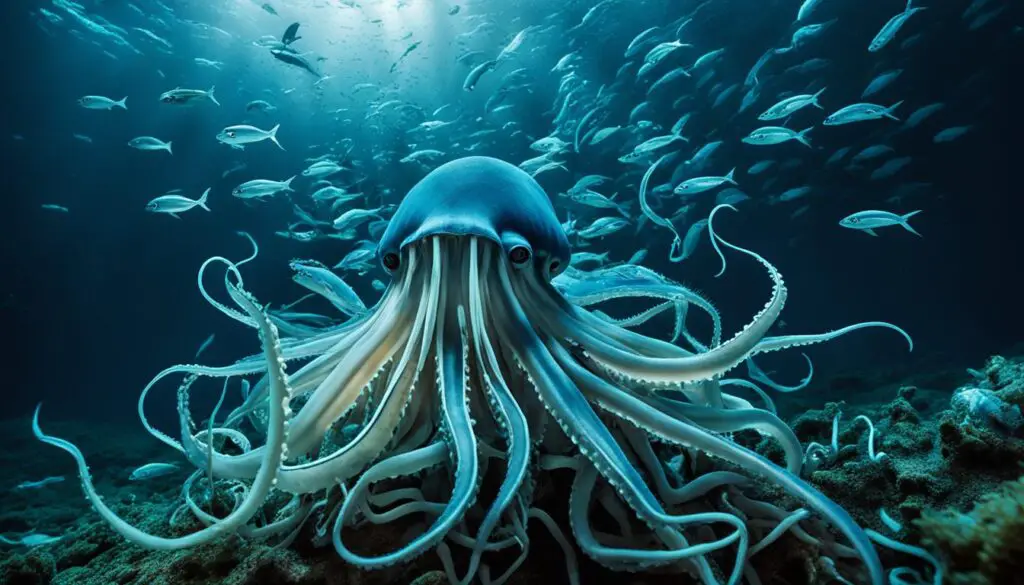
Predators of Giant Squids
Giant squids live in deep ocean waters, facing many challenges. They are top predators but have their own threats from larger sea creatures. These threats show how complex their ocean world is.
Whales and their interactions with giant squids
Sperm whales are known to hunt giant squids. They dive deep to find them. These whales use echolocation to find giant squids in the dark.
Their size scares off smaller squids, making them a big threat.
Other potential threats to giant squids
Other than whales, deep-sea sharks and big fish also threaten giant squids. They go after young or small giant squids. Giant squids use fast swimming and ink to escape these dangers.
Communication and Interactions within the Deep Sea
Giant squids have unique ways of talking to each other. This shows how complex their behaviors are and how they interact with others in the ocean. These ways help them deal with other sea creatures.
Physical communication methods used by giant squids
Giant squids mainly use visual signals to talk to each other. They change their skin color and texture to send messages. This is key in finding a mate or settling disputes over territory.
These visual changes warn other squids and also keep away potential dangers. It’s a smart way for them to communicate in the dark sea.
Potential for chemical signaling
Giant squids might also use chemical signals. By releasing pheromones, they could attract a mate or scare off rivals. This shows they have a complex social life in the deep sea.
Studying these signals helps us understand their social world better. It shows how they live and interact in the deep, mysterious ocean.
The Impact of Habitat on Giant Squids’ Interactions
Understanding where giant squids live is key to knowing how they act and interact with others in the ocean. They live in temperate zones, mostly between 300 to 1,000 meters deep. This choice of home greatly shapes their behavior, how they hunt, and their interactions with other sea creatures.
Preferred habitat and its effects on behavior
Giant squids pick their homes carefully, which affects how they interact with other sea life. In these deep areas, they’ve adapted to live and hunt well. They plan their hunts based on the sea life around them, keeping the ecosystem balanced and boosting their hunting success.
Temperature and depth influences on marine interactions
Temperature and depth are big factors in how giant squids interact with the ocean. Changes in water temperature can change their metabolism and activity levels. This can make them more or less vulnerable to predators and change how they interact with prey or rivals. Looking into these factors helps us understand how giant squids fit into the ocean’s complex web of life.

